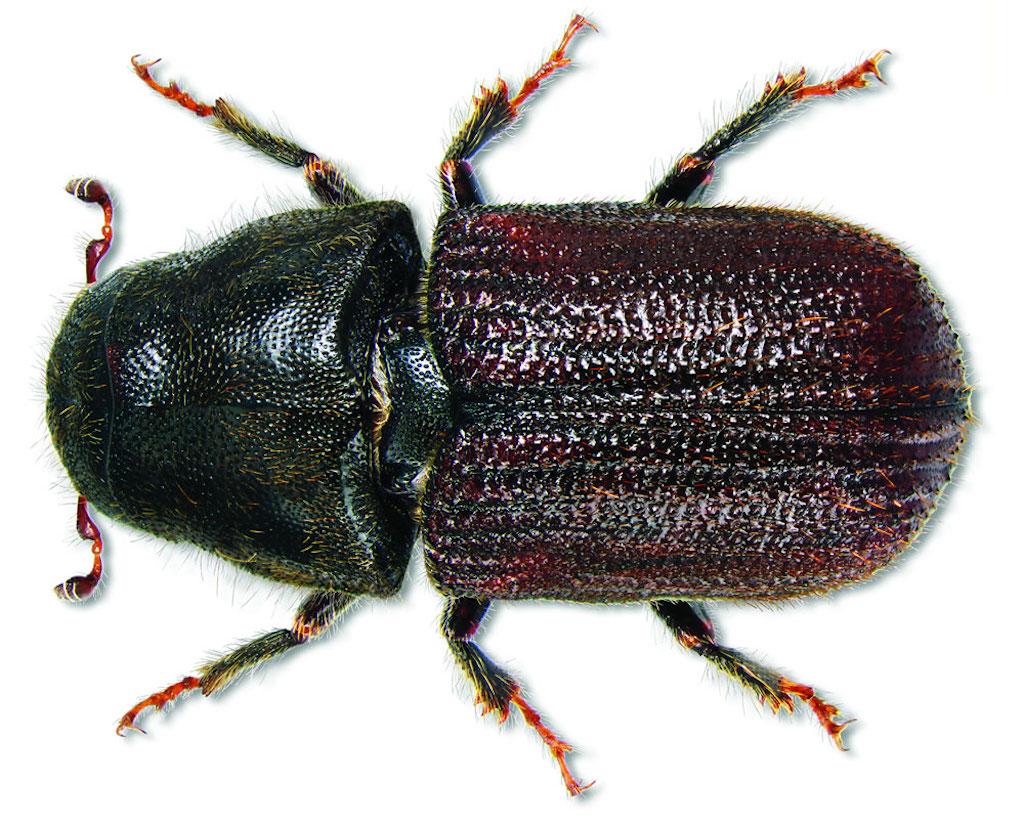
Although we see the effects of mountain pine beetles, we don't usually see the actual beetles/Natural Resources Canada
As mountain pine beetles turn the forests red around Jasper National Park, Parks Canada staff are fighting back to protect the town from wildfire threats and the forests from the harmful pests.
Landon Shepherd, fire and vegetation specialist, says a recent injection of federal funding has allowed the park to deal with some of the impacts of the beetle. Fire prevention is the priority because a large chunk of forest has “gone red” (been killed by the beetle) and there’s a significant risk of fire.
Shepherd is helping “augment and expand” a high-volume sprinkler system that protects the town of Jasper. Staff are clearing patches of land and thinning the forest “as a way of creating a more defendable line.”
Because of climate change, the mountain pine beetle has been able to expand its range northward and eastward from British Columbia and toward higher elevations. The beetle has killed massive tracts of formerly healthy forests that sheltered wildlife, including many species at risk.
The mountain pine beetle is a wood-boring insect native to western North America that attacks a wide range of pine trees including lodgepole, ponderosa, western white, whitebark, limber and jack. Its predators — insects, parasitoids and woodpeckers — don’t have enough impact to control new or outbreak populations.
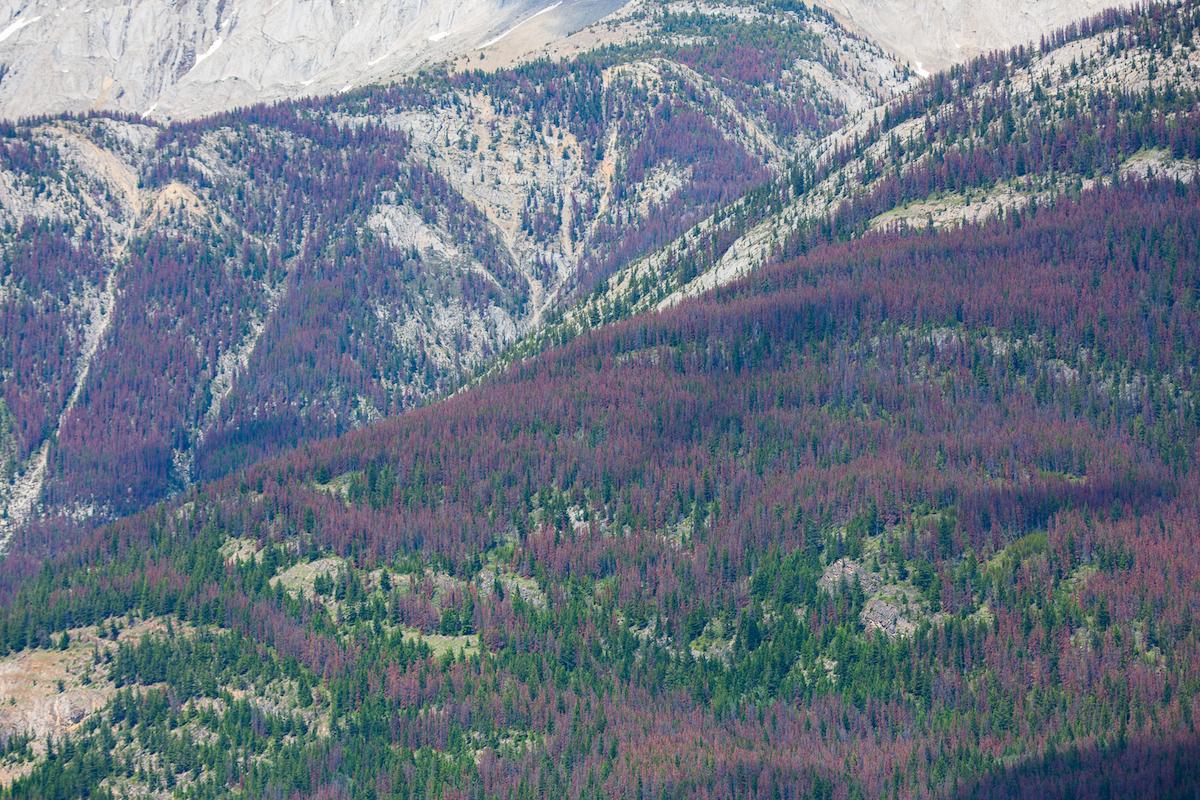
An aerial view of the effects of mountain pine beetles on Jasper National Park/Parks Canada/Sanne van der Ros
A pine beetle outbreak that started in British Columbia in the early 1990s has now impacted more than 18 million hectares (44 million acres) of forest and migrated into north-central Alberta’s boreal forest. Researchers say adult beetles can fly more than 100 kilometres (60 miles) in good weather to new trees.
“Historically, it’s a native insect that occurs in B.C. and the western U.S.A.,” says Shepherd. “It always had that background presence, but it didn’t have a significant presence until the 1990s. Around the early 2000s, the beetles took advantage of a large wind event and there was a mass flight and it went across the Rocky Mountains and into Alberta a few hundred kilometres north and east of Jasper National Park.”
Healthy trees can defend and suppress an attack by producing a toxic resin, but as more beetles arrive and reach epidemic levels, their natural defences are overwhelmed. The beetle’s numbers only decline when all large pine trees are weakened or dead.
“They don’t go into the wood,” says Shepherd. “They eat the living part between the bark and the wood, which kills the tree.”
In November, the federal government pledged $68 million ($53.9 million USD) through Natural Resources Canada to help control, research and mitigate the impacts of this pest in the Rocky Mountains in British Columbia and Alberta.
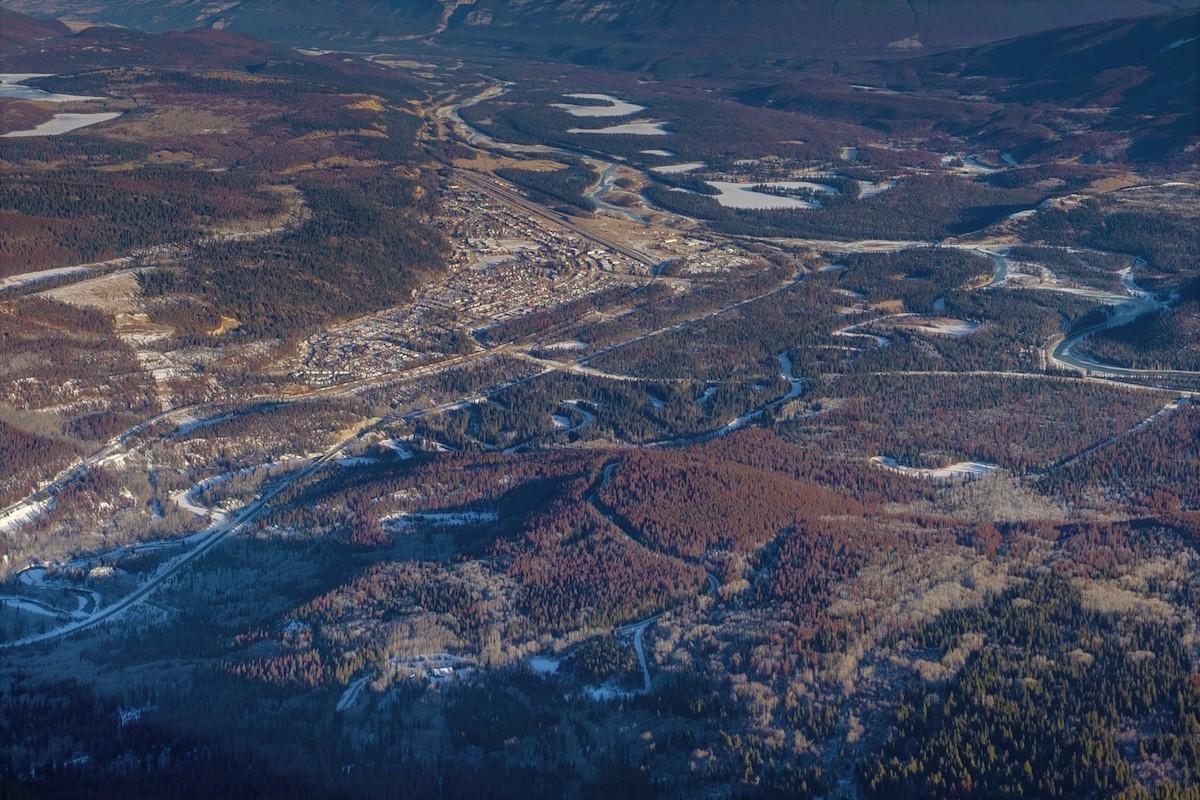
An aerial view of the town of Jasper and surrounding national park forest/Parks Canada/Rogier Gruys
Parks Canada will get $6.9 million ($5.4 million USD) over three years for work in Jasper, Banff National Park, Kootenay National Park and Yoho National Park. The work — surveying, planning and reducing wildfire risk — will be concentrated in the forests surrounding communities within the four parks.
“The Rocky Mountain national parks are of significant importance to Canadians, including Indigenous peoples who lived on the land for millennia,” Jonathan Wilkinson, Minister of Environment and Climate Change and Minister Responsible for Parks Canada, said in a news release for the funding announcement. “Due to the impacts of climate change, the mountain pine beetle represents a significant threat to the preservation of these iconic places.”
Jasper has been the hardest hit and will get the bulk of the government money.
Shepherd says the park had been doing an annual pine beetle count since the 1990s and that 2013 was “the last year we were able to count individual dead trees.” There were 1,900. The next year, several thousand hectares of affected forest had “gone red.”
From 2014 to 2019, park staff noticed “a doubling or more than doubling of the extent that the mountain pine beetle was colonizing the forest.” It’s never “all the trees in the forest,” says Shepherd, but it’s always five to 30 per cent of the mature pines, especially lodgepole pines.
The park has received parcels of funding since the early 2000s, but the recent federal pledge is the “most significant chunk of money for sure,” says Shepherd.
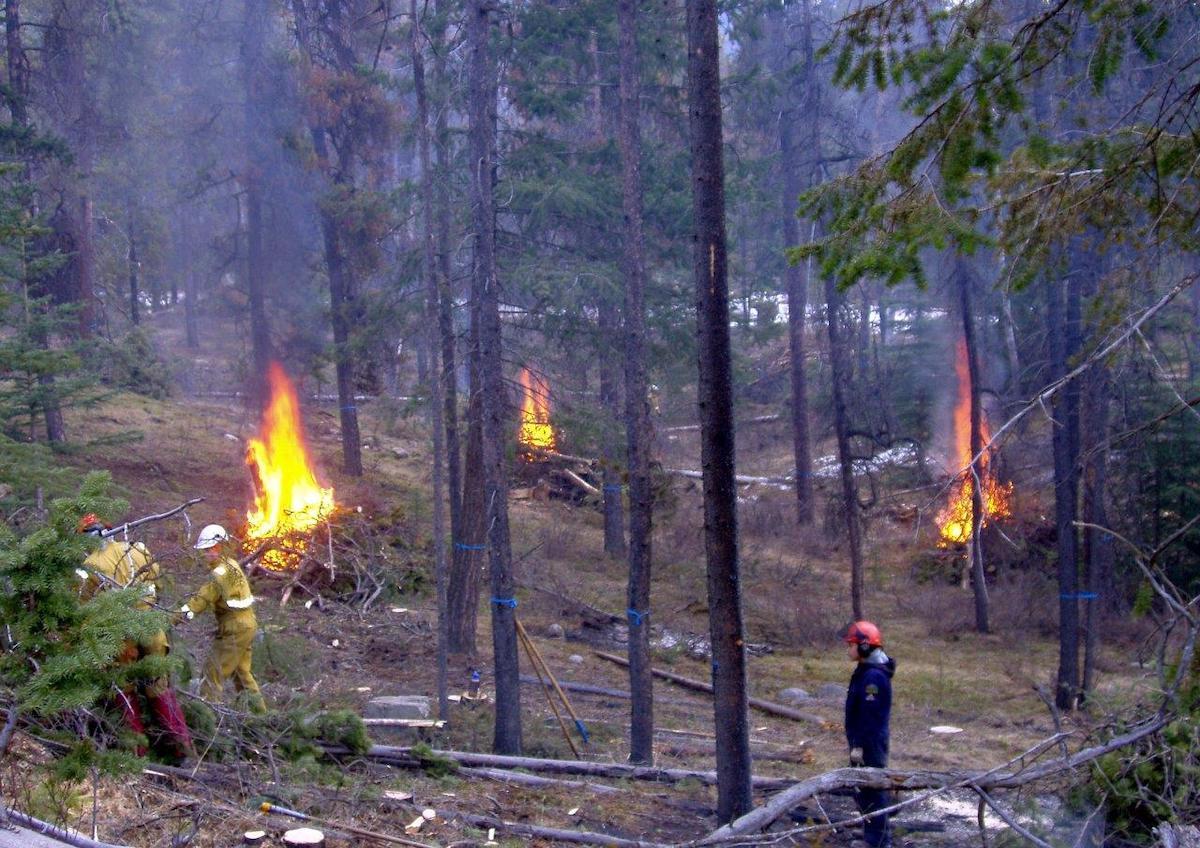
Burning piles of branches and needles from pine beetle-afflicted trees in Jasper National Park/Parks Canada
The top priority is wildfire risk reduction. Live trees, Shepherd points out, store rain in their roots and branches. Dead trees, with hanging branches and needles, “can dry out pretty quickly following a rain event” as water lands on top of the trees and evaporates. “It means that a large proportion of the forest canopy is ready to burn again after a rain event and we need to prepare for that risk.”
Wildfires are typically caused in equal measures by lighting, railways (things such as seized brakes and maintenance activities) and humans (illegal camping). The season for lightning, once contained between June to early September, has expanded because of climate change and lasts from May to late October. Jasper extends more than 11,000 square kilometres (4,200 square miles) and lightning strikes in the park tend to be in remote spots that aren’t easy to access and are often out of view and so not immediately spotted.
Along with bolstering the community fireguard and expanding the existing sprinkler system, Parks Canada is an active member of FireSmart Canada, a program that boosts community resilience to wildfire. It’s removing hazardous trees in its Wapiti and Wabasso campgrounds to reduce the risk of trees falling, the amount of fuel surrounding campsites and the risk of wildfire spread. The park will be doing fire risk reduction at the Cultural Use Area — a dedicated space created in cooperation with Indigenous partners — and planting Douglas firs and other replacement trees in various spots. Some money will go to community partners.
Beetle populations thrive with mild winters and warm, dry summers. They typically have a one-year lifespan. Adults colonize new host trees in July and August. Females release chemicals called aggregation pheromones — inviting other beetles to come to that tree — and then eat tunnels (galleries) into the inner bark to lay eggs. Newly hatched larvae eat further into the tree and usually winter in it, pupating the following June or July.
Shepherd sees two key things contributing to the mountain pine beetle’s recent success in Alberta — a lack of “really cold lethal temperatures” and a long period of fire suppression.
“Because of climate change, we don’t get as many cold temperatures and beetle-killing events as we used to,” he says. “If we have three days below minus 40, the beetle larvae freeze and are killed.” As well, the park doesn’t see natural fire regimes and Indigenous fire practices like it used to.
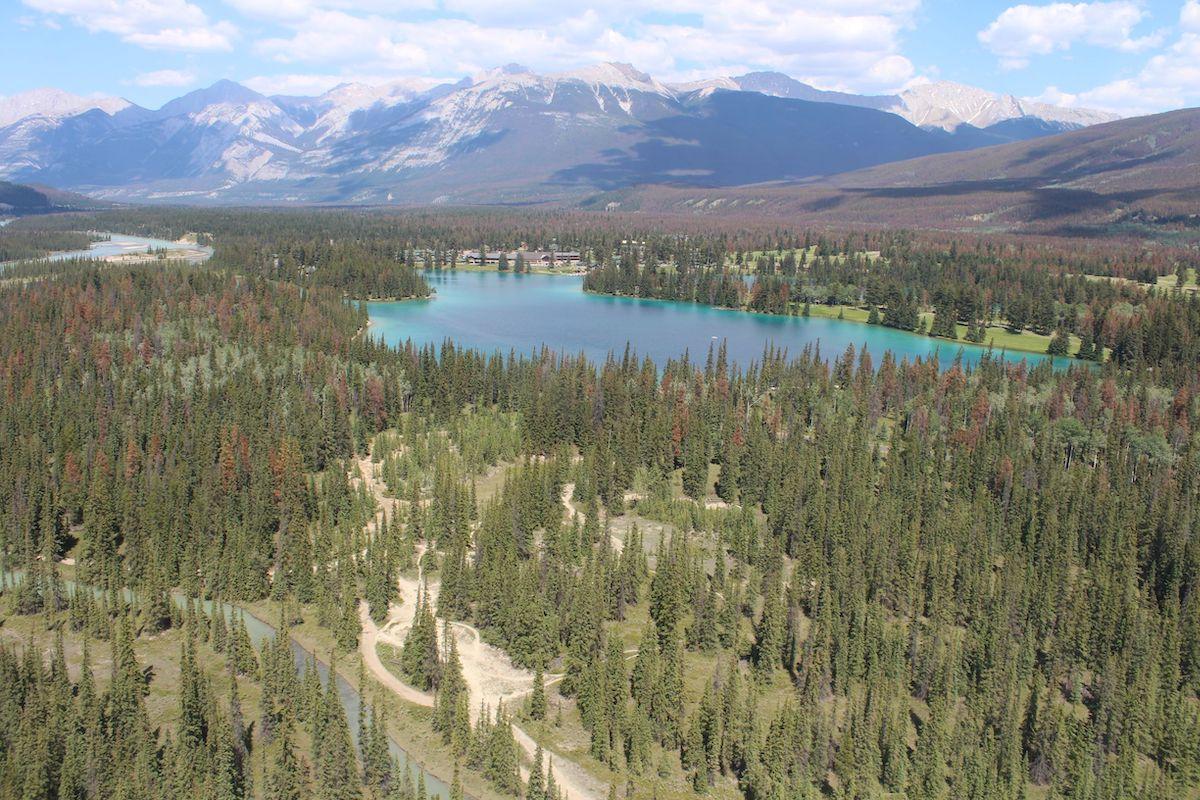
Beautiful Jasper National Park has a sea of dead pine trees because of mountain pine beetles/Parks Canada
But in the winter of 2019, Alberta experienced a six-week cold snap and 95 per cent of the pine beetle larvae were killed. “It didn’t stop mountain pine beetles in Alberta," says Shepherd, "but it really helped knock that population back.” Then in January 2020, Jasper had three days of minus 40 Celsius (also minus 40 Fahrenheit) that killed 98 per cent of the remaining beetles. The effect of whatever happens to the beetle in one winter isn’t seen until surveys are done the next fall, says Shepherd.
While Parks Canada doesn’t use attractant pheromones in the park given the massive amount of territory it covers, it does use an anti-aggregation pheromone called Verbenone and Green Leaf Volatile. Shepherd says “it signals that this tree is full so go somewhere else. It also says `I’m not a pine tree anyway so there’s nothing here for you.’”
With the government funding, Jasper is working on an updated vegetation mapping inventory of the park, something that hasn’t been done since the 1980s and that will detail tree cover and composition as well as shrubs and help identify what mammals are likely to be there. It should be complete by 2023.
“More than half of the forest landscape of Jasper National Park has been significantly altered by mountain pine beetles,” says Shepherd, “and so it’s a really critical transition point for Jasper’s forest to be able to assess and move forward.”
While Jasper has been the hardest hit, Banff, Yoho and Kootenay will all continue FireSmart work and continue working on a mix of strategic, wildlife risk and firebreak plans.



Comments
Always pushing climate change. The real culprit is explorers in the early 20th century who burned the land to expose rock so their mineral content could be determined. 100 years later, the pine trees are all 100 years old and prime age for the bark beetles to feast and reproduce... but climate change.